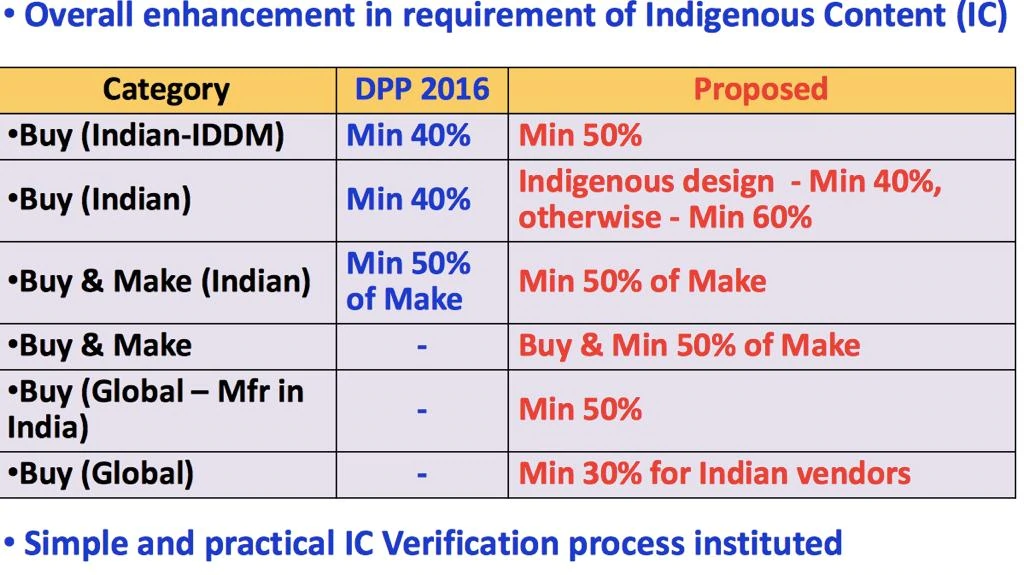
SOURCE: INDIA TODAY
efence minister Rajnath Singh today released the government’s Defence Acquisition Procedure (DAP)-2020, a renamed version of the Defence Procurement Policy (DPP). The DAP-2020 lays down guidelines for the ministry of defence (MoD) to acquire weapons and equipment.
The DAP-2020, which has been in the works for a year, is significantly focused on indigenisation and realising the government’s ‘Atmanirbhar Bharat (self-reliant India)’ goal. Among the highlights are the notification of a list of weapons and platforms banned from imports, the indigenisation of imported spares, and exploring the willingness of prospective foreign vendors to progressively undertake manufacturing as well as setting up of indigenous ecosystems even at the spares and sub-component levels.
The DAP which comes into effect on October 1, 2020 ends defence offsets in three categories- Government to Government deals, Inter-Governmental Agreements and resultant single vendor deals (where only one manufacturer is found to be compliant with all the requirements of the armed forces). The defence offsets policy mandates a foreign original equipment maker must invest between 30 and 50 per cent of the value of a contract in sourcing parts and components from Indian industry
As part of its plan to leverage India’s position as the world’s second-largest arms importer and kick-start an indigenous defence ecosystem, the DAP has introduced a new category of ‘Buy (Global-Manufacture in India)’. ‘Buy (Global)’ is a category where the entire platform is imported from a foreign supplier with no production in India. ‘Buy (Global-Manufacture in India)’ calls for ‘manufacturing either the entire or a part of the equipment or spares and assemblies and sub-assemblies, maintenance, repair and overhaul for the equipment through its subsidiary in India’.
The MoD reasons this is being done to encourage foreign OEMs (original equipment manufacturers) to set up ‘manufacturing/maintenance entities’ through their subsidiaries in India while enabling requisite protections to the domestic industry.
What the DAP does, or at least intends to do, is to effectively end off-the-shelf purchases, which do not have any indigenous content (IC). ‘Buy (Global)’ has traditionally been at the bottom of MoD’s desirability chart (see table enclosed), topped by Indigenously Designed Developed and Manufactured (IDDM) products. This is because off-the-shelf products involve a huge foreign exchange outgo and no technology benefits to Indian firms apart from lifelong dependence on the supplier for spares and servicing. These acquisitions, however, go through because often no competing systems are available. A case in point being the five S-400 missile systems worth $5.43 billion (Rs 40,058 crore) that India bought off the shelf from Russia and the 10 C-17 GlobemasterIII heavy lift aircraft purchased from the US for over $4 billion (Rs 29,509 crore).
In the revised ‘Buy (Global)’ category, the DAP stipulates that the OEM will need to put in Indian content to the tune of 30 per cent of the contract value. For ‘Buy (Global-Manufacture in India)’, the OEM will need to ensure that 50 per cent of the value of the contract is sourced from Indian firms. It remains to be seen how this policy will be implemented and how effective is the ‘simple and practical indigenous content verification process’ that the MoD claims to have put in place.
The way forward, according to defence ministry officials, is for foreign OEMs to set up subsidiaries in India taking advantage of the government policy announced in May this year which allows 74 per cent FDI in defence manufacturing (it was 49 per cent earlier). Foreign OEMs with a majority stake will be considered as Indian firms, eligible to participate in ‘Buy Indian’ and ‘Buy and Make Indian’ contests that were previously open only for Indian companies.
India plans to spend $130 billion (Rs 9.59 lakh crore) on military modernisation over the next five years. The government has opened up the defence industry for private sector participation to provide an impetus to indigenous manufacturing.
The DPP has been revised in 2005, 2006, 2008, 2009, 2011 and 2013, adding new categories like ‘Make’, ‘Buy and Make’ and ‘Make (Indian)’ as well as the concept of offsets and ship-building procedures since governments, over the years, have pursued ways to reduce India’s crippling dependence on imported military hardware.






